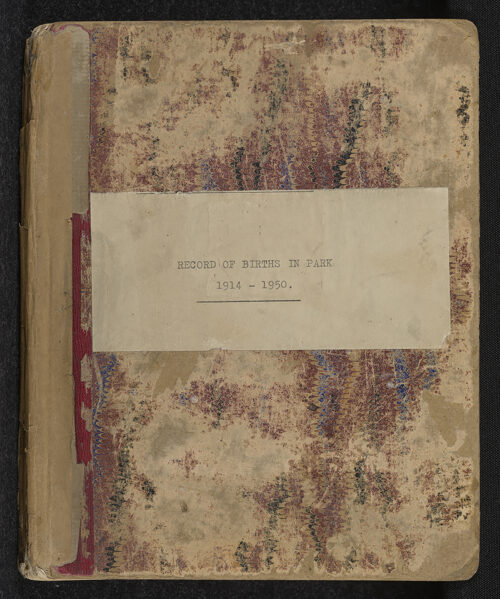This spring the short but broad digitisation project, OneHealth, reached its end. The OneHealth project was focused on early animal welfare history, utilising new material brought in from a trio of organisations: Royal Zoological Society of Scotland, The Royal (Dick) School of Veterinary Studies, and the animal welfare charity OneKind. During those 6 months, we had a vast and diverse materials pass through our studios. From the historically rich early records of Edinburgh Zoo to morbidly curious Veterinary School implements to the delightfully pet centric magazines of the OneKind charity, the project spanned a wide range of items.

To begin with, the Royal Zoological Society of Scotland (RZSS). The materials we focused on digitising were principally the details of purchases, sales, births, and deaths of all animals within Edinburgh Zoo. We began with the very earliest records, from 1914, when the zoo was nascently formed. From this date we worked forwards chronologically. Digitisation was challenging due to two factors: size and quantity. Firstly, the ledgers themselves were large tomes, being wide and weighty, making them cumbersome to photograph and work with. Secondly, again relating to largeness, the sheer quantity of pages and ledgers to complete really added to the project time!

Being effectively a century old spreadsheet, it could be hard to find something remarkable to comment on. However, within the thousands of entries, there is one that stands out – a king penguin born in 1919. This penguin is of great note, being the first penguin species to be born north of the equator. This hemisphere pioneering penguin was but one point in Edinburgh Zoos penguin history. Being initially brought over by Lord Salvesen on whaling ships, Edinburgh Zoos penguin connection was further solidified during a visit by Major Nils Egelien to the zoo in 1961. The major was a member of the Norwegian King Guard, who were in Edinburgh for the military tattoo. He was especially taken with the descendants of our aforementioned king penguin, remarking that they marched in a similar manner to his own troops. He returned in 1972 and formally adopted a penguin as mascot for the Kings Guard, naming him Sir Nils Olav III. The penguin was also granted the rank of lance corporal but rose through the ranks to Major General – the highest military rank of any known penguin. (Though there is little competition for that record.)
We also digitised work from OneKind, an animal welfare charity based in Scotland. They have gone through a number of names, being initially founded as the Scottish Society for the Prevention of Vivisection in 1911, before rebranding as Advocates for Animals in 1990 and then ultimately landing on the name OneKind in 2010. We focused primarily on materials from the beginning of the charity when it went by the Scottish Society for the Prevention of Vivisection. This was mostly loose-leaf material, such as flyers and magazines, which made for a smooth digitisation process.
The magazine was called Our Fellow Mortals and was a sporadically released feature containing information about the charities’ work and fundraising (initially focused around ceasing vivisection in education). As the magazine went on, it grew to include stories of animal interest and original photography, heavily dominated by one subject: the charity workers’ dogs.
From Little Tich to Tony, Kelpie to Roy, Captain, Bess, Duke and Jean, every issue featured a veritable pack of adorable dogs. If ever there was text attached, it proved that regardless of time people have always been obsessed with their dogs in almost the exact same ways. Heavily anthropomorphized in the text, the dogs would be written as if officially inviting people to attend their fundraising bazaars. The entire thing is uncannily similar to dogs in modern day internet culture, demonstrating how people have seemingly always been the same.
Finally, The Royal (Dick) School of Veterinary Studies. Formed in 1823 by William Dick, son of a blacksmith and farrier, the school is still frequently awarded the best veterinary school in the UK. From the school we received the most varied assortment of items of all the institutions. We had objects like implements, medicines and specimens and written materials like lecture notes, handbooks, and ledgers. The objects proved some of the most interesting subjects to photograph, as they often required some thought in their handling and framing.
One such handling curiosity was the sealed vials of arsenic, morphine, and cocaine – for curing your dog of all that ails it. These were produced in the 1940s for veterinary use and photographed beautifully by my colleague Malcom. Where he had the medicine to photograph, I had the delivery systems. A selection of reusable needles and syringes, varying in size from the small and delicate to large and frightening, to be handled with quite some care. No one wants a century old infection of mysterious animal origin.
For me, the OneHealth Project was my first while working at the university. It was always an interesting one to work on and a fantastic opportunity to learn digitisation process for a wide range of materials. It is a shame that the project is now at an end, as in digitisation there is always more that could be done, but we achieved a lot with the time we did have. Thankfully, RZSS has also extended some funding, so in the future there should be more animal adjacent collections to share!
George Hodgson, Photographer






Be First to Comment